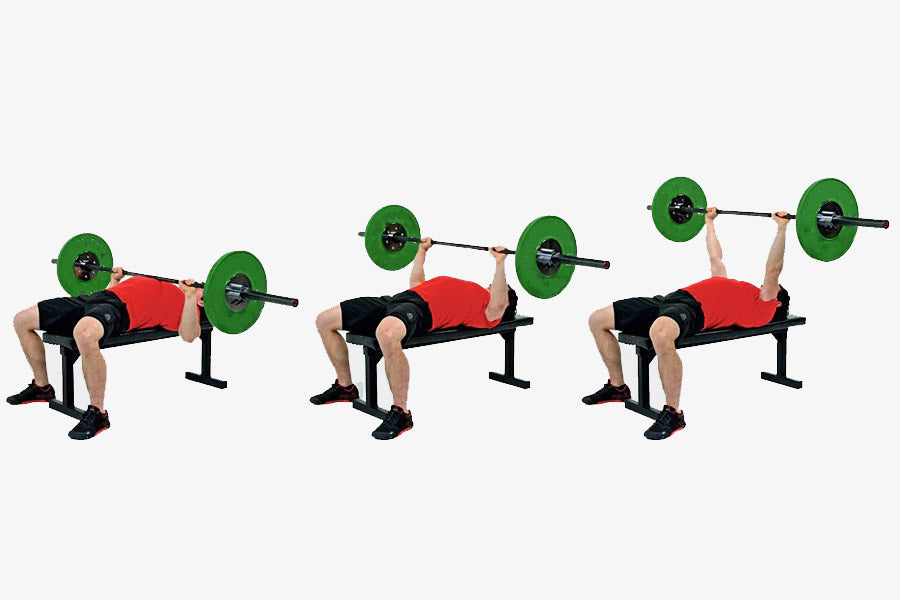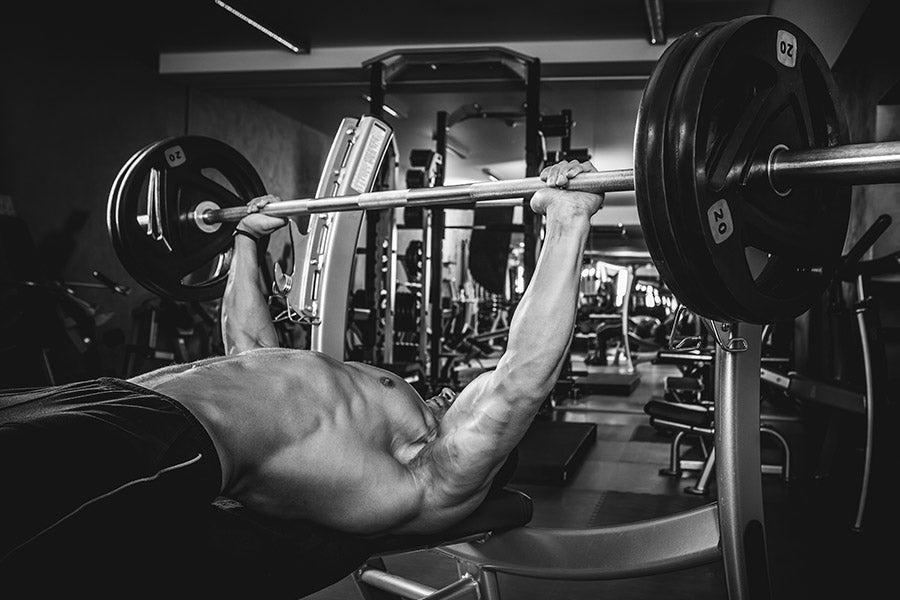There's nothing quite like the feeling of hitting a new personal best in the bench press. The sense of accomplishment, the validation that all your blood, sweat, and tears in the gym are paying off, it's an unbeatable feeling.
But if your bench press form is anything less than perfect, you're not only risking injury but also sacrificing precious gains. In this article, we'll show 7 of the most common mistakes people make when bench pressing and how to fix them.
So whether you're a beginner just starting or a professional looking to take your training to the next level, read on and learn how to bench press with proper form.
How to Bench Press

Before we discuss the bench press mistakes and fine-tuning of your bench press form, let's go over the fundamental steps.
- Lie flat on your back on a bench.
- Hold the bar with your hands slightly wider than shoulder-width apart so that your hands will be directly above your elbows when you complete the action. It is possible to generate the most force this way.
- Carefully lower the bar to your chest as you inhale.
- Exhale, push up while firmly grasping the bar, and keep your eyes on the ceiling rather than the bar to make sure it follows the same path each time.
The following are some of the general bench press tips shared by powerlifter Jenna McKean:
Contact Points
- Keep your feet directly beneath or behind your knees. Press your feet into the ground to tighten your hamstrings and glutes.
- Throughout the lift, you should keep your head, shoulders, and hips on the bench. Your shoulders must retract and press firmly into the bench to build a sturdy foundation.
Setup
- Keep the bar squarely beneath your eyes and no higher than your wrists when your arms are locked overhead.
- Lay your hands on the bar slightly farther apart than your shoulders.
Un-Racking/Re-Racking
- Start with a solid lock-out where the bar is precisely over your shoulders to unrack it.
- Press until your elbows are straight once you have the bar under control and have lowered it for one or two seconds.
- Carefully re-rack and ensure the bar is stable before releasing the tension in your arms.
Related Article: 4-Day Barbell Workout Without a Rack for Complete Muscle Gain
7 Common Bench Press Mistakes
The bench press is a staple of many weightlifting routines, but it's also one of the most commonly misplayed exercises. Here are seven mistakes you might be making when you hit the bench:
1. Elbows Too High
Your shoulder capsules and elbows are under great stress when you bench press with your elbows straight out to the sides. This error causes the barbell to travel farther since it crosses your collarbones rather than your sternum when viewed from above.
So, as you lower the barbell, hold it with a narrower grip and maintain your elbows close to your ribcage. Your upper arms should meet your torso at a 45° angle, as viewed from above.
2. Bouncing the Bar
Avoid bouncing the bar on your body during the bottom section of the bench press because this cheats the exercise by generating momentum that makes the barbell lighter to lift. If the weight is heavy enough, you could also damage your ribs.
If the barbell needs to be bounced, it's probably too heavy. Decrease the weight and touch it lightly on your body; for strength, pause the barbell on your chest before pushing.
3. Not Getting a Liftoff
It's challenging to return the barbell to the beginning position without compromising your posture without a liftoff. For instance, to push the weight up and out of the pins, your shoulders may round forward, and the tightness in your upper back will go away. However, drawing your shoulder blades back together is challenging once you have the weight supported over your body.
Instead, take a moment to position yourself correctly, pulling your shoulder blades in and down, and then ask a partner to hand you the barbell. If a spotter isn't available, raise the pins until you can take the barbell off the rack without hunching over. If necessary, bench press in the power rack.
4. Not Pausing Before Descent
Avoid starting your bench press immediately after you lift the bar off the ground; hold it there. Wait for a second; your body will sink and lock into the bench, adding greater stability for the press. Additionally, it will make you feel tenser all over your body.
5. Not Using Your Legs
As you bench press, avoid tapping your feet or wiggling your legs. Instead, plant your feet firmly in the ground and create a solid foundation during setup. Additionally, contract your glutes and quads to increase overall body tightness and your ability to lift heavier objects.
People frequently avoid "targeting their core" by placing their feet on the bench. If you want to develop a powerful and enormous upper body, concentrate on lifting more weight with the bench press rather than working on your abs. The bench press is a strength workout, not a core exercise.
A Spider-Man pushup is better if you want to tone your chest and work your core simultaneously.
Related Article: Glute Workout: The Expert Guide to the Ultimate Glute Workout for Men
6. Breaking Your Wrists
Your lift will succeed or fail, depending on how you hold the barbell. (As well as your wrists.) If you hold the barbell too tightly in your palm or around your fingertips, your wrist will bend backward, which can cause two issues: First, you'll lose strength since the line of force from your elbows and forearms won't pass through the barbell directly from a side perspective.
Second, you'll injure your wrists since the hefty barbell strains the tendons and joints, especially as the weights get larger. Instead, maintain your wrists slightly bent and firmly grasp the barbell.
7. Lifting Your Head Off the Bench
Your body becomes an arch from your feet to your shoulders as you lift your hips, which greatly strains your spine. Avoid doing this. Always keep your glutes on the bench. Additionally, use your thoracic spine and upper back to arch rather than your lower back.
FAQs
1. Why am I not progressing with my bench press?
There could be several reasons you are not progressing with your bench press. One possible factor might be that you are not adequately engaging the muscles involved in the movement, which means you are not getting enough strength or power out of each repetition.
Another potential issue may be that you are trying to stretch too far, which can stress your tendons and ligaments. Additionally, it may just be a matter of focusing more on technique and form when performing the exercise or adjusting your training routine to target different muscle groups more effectively.
Whatever the case, it is important to consult a fitness professional or coach who can assess your technique and provide advice to help you accomplish your goals.
2. How do I save myself from a failed bench press?
There are multiple things that you can do to perfect your bench presses. According to Luis Cornier (performance Coach at Precor), the ideal move is rolling the bar down your sternum, through the middle of your chest, past your abdominals, and directly beside your hips. You can get up and deadlift the bar back to the starting position. This is how you can save yourself from a failed bench press.
3. Should I feel a bench press on my shoulders?
No, it means when you bench, your shoulders take over, and you have poor posture. Ensure that only your shoulder blades and glutes are in contact with the bench. Your spine and the bench should be separated.
4. Why is my chest not sore after bench pressing?
As your body gets used to benching, you might not have chest soreness afterward. Growth is not measured by soreness. The lack of chest soreness may be due to technical errors, other muscles' use, the stabilizer muscles' weakness, and insufficient training volume.
The Bottom Line
The bench press is an amazing exercise targeting your pectoral muscles, arms, and shoulders. It has various benefits, but there are chances that you make mistakes doing it. We have listed seven of the most common bench press form mistakes that could impede your progress. All it takes to fix them is a bit of focus and attention to detail during your next workout. Remember, practice makes perfect—the more you do it, the better you’ll get at nailing that benches form and reaping all the benefits that come with it.











